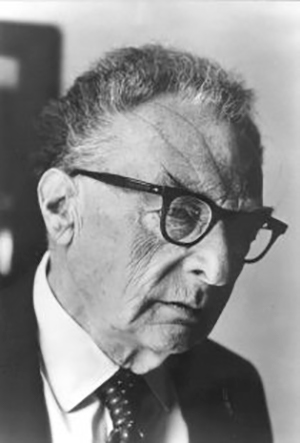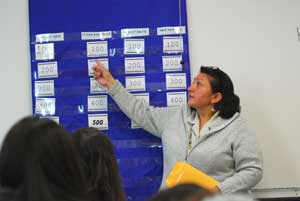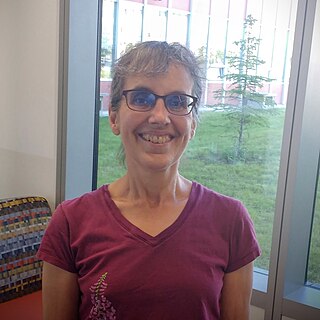Related Research Articles

Language is a structured system of communication that consists of grammar and vocabulary. It is the primary means by which humans convey meaning, both in spoken and signed forms, and may also be conveyed through writing. Human language is characterized by its cultural and historical diversity, with significant variations observed between cultures and across time. Human languages possess the properties of productivity and displacement, which enable the creation of an infinite number of sentences, and the ability to refer to objects, events, and ideas that are not immediately present in the discourse. The use of human language relies on social convention and is acquired through learning.
Phonology is the branch of linguistics that studies how languages systematically organize their phones or, for sign languages, their constituent parts of signs. The term can also refer specifically to the sound or sign system of a particular language variety. At one time, the study of phonology related only to the study of the systems of phonemes in spoken languages, but may now relate to any linguistic analysis either:

Roman Osipovich Jakobson was a Russian and naturalised American linguist and literary theorist.
Linguistic typology is a field of linguistics that studies and classifies languages according to their structural features to allow their comparison. Its aim is to describe and explain the structural diversity and the common properties of the world's languages. Its subdisciplines include, but are not limited to phonological typology, which deals with sound features; syntactic typology, which deals with word order and form; lexical typology, which deals with language vocabulary; and theoretical typology, which aims to explain the universal tendencies.
Historical linguistics, also known as diachronic linguistics, is the scientific study of how languages change over time. It seeks to understand the nature and causes of linguistic change and to trace the evolution of languages. Historical linguistics involves several key areas of study, including the reconstruction of ancestral languages, the classification of languages into families, and the analysis of the cultural and social influences on language development.

The Andamanese languages are the various languages spoken by the indigenous peoples of the Andaman Islands in the Indian Ocean. There are two known Andamanese language families, Great Andamanese and Ongan, as well as two presumed but unattested languages, Sentinelese and Jangil.
In linguistic typology, ergative–absolutive alignment is a type of morphosyntactic alignment in which the single argument ("subject") of an intransitive verb behaves like the object of a transitive verb, and differently from the agent ("subject") of a transitive verb. Examples include Basque, Georgian, Mayan, Tibetan, and certain Indo-European languages. It has also been attributed to the Semitic modern Aramaic languages. Ergative languages are classified into two groups: those that are morphologically ergative but syntactically behave as accusative and those that, on top of being ergative morphologically, also show ergativity in syntax. No language has been recorded in which both the morphological and syntactical ergative are present. Languages that belong to the former group are more numerous than those to the latter. Dyirbal is said to be the only representative of syntactic ergativity, yet it displays accusative alignment with certain pronouns.
A nasal vowel is a vowel that is produced with a lowering of the soft palate so that the air flow escapes through the nose and the mouth simultaneously, as in the French vowel /ɑ̃/ or Amoy []. By contrast, oral vowels are produced without nasalization.

Yurok is an Algic language. It is the traditional language of the Yurok people of Del Norte County and Humboldt County on the far north coast of California, most of whom now speak English. The last known native speaker, Archie Thompson, died in 2013. As of 2012, Yurok language classes were taught to high school students, and other revitalization efforts were expected to increase the population of speakers.
In geolinguistics, areal features are elements shared by languages or dialects in a geographic area, particularly when such features are not descended from a proto-language, i.e. a common ancestor language. That is, an areal feature is contrasted with lingual-genealogically determined similarity within the same language family. Features may diffuse from one dominant language to neighbouring languages.
Nhanda, also rendered Nanda, Nhanta and Nhandi, is an Australian Aboriginal language from the Midwest region of Western Australia, between Geraldton and the Murchison River, from the coast to about 20 kilometres inland. The language is now spoken, or semi-spoken, by only a few people.
Larry M. Hyman is Distinguished Professor Emeritus of Linguistics at the University of California, Berkeley. He specializes in phonology and has particular interest in African languages.

Ongan, also called Angan, South Andamanese or Jarawa–Onge, is a language family which comprises two attested Andamanese languages spoken in the southern Andaman Islands.
Linguistics is the scientific study of language. The areas of linguistic analysis are syntax, semantics (meaning), morphology, phonetics, phonology, and pragmatics. Subdisciplines such as biolinguistics and psycholinguistics bridge many of these divisions.

Rupert Gerritsen was an Australian historian and a noted authority on Indigenous Australian prehistory. Coupled with his work on early Australian cartography, he played an influential part in re-charting Australian history prior to its settlement by the British in 1788, and noted evidence of agriculture and settlements on the continent before the arrival of settlers.
Palantla Chinantec, also known as Chinanteco de San Pedro Tlatepuzco, is a major Chinantecan language of Mexico, spoken in San Juan Palantla and a couple dozen neighboring towns in northern Oaxaca. The variety of San Mateo Yetla, known as Valle Nacional Chinantec, has marginal mutual intelligibility.
Panchronic phonology is an approach to historical phonology. Its aim is to formulate generalizations about sound changes that are independent of any particular language or language group.

Keren D. Rice is a Canadian linguist. She is a professor of linguistics and serves as the Director of the Centre for Aboriginal Initiatives at the University of Toronto.
Evolutionary Phonology is an approach to phonology and historical linguistics, based on the idea that recurrent synchronic sound patterns, if not inherited from the mother tongue, are the result of recurrent sound changes, while rare patterns are the product of rare changes or a combination of independent changes.
The usage-based linguistics is a linguistics approach within a broader functional/cognitive framework, that emerged since the late 1980s, and that assumes a profound relation between linguistic structure and usage. It challenges the dominant focus, in 20th century linguistics, on considering language as an isolated system removed from its use in human interaction and human cognition. Rather, usage-based models posit that linguistic information is expressed via context-sensitive mental processing and mental representations, which have the cognitive ability to succinctly account for the complexity of actual language use at all levels. Broadly speaking, a usage-based model of language accounts for language acquisition and processing, synchronic and diachronic patterns, and both low-level and high-level structure in language, by looking at actual language use.
References
- ↑ "Faculty". www.gc.cuny.edu. Retrieved 2022-03-15.
- 1 2 "Curriculum Vitae" (PDF). Retrieved 26 February 2017.
- ↑ "Alumni and their Dissertations – MIT Linguistics". linguistics.mit.edu. Retrieved 2022-03-15.
- ↑ "Who | Endangered Language Alliance". elalliance.org. Retrieved 2017-02-27.
- ↑ "Juliette Blevins". scholar.google.com. Retrieved 2022-03-15.
- ↑ "IE and Basque".
- 1 2 Blevins, Juliette (2004). Evolutionary Phonology: The Emergence of Sound Patterns. Cambridge University Press. ISBN 978-0521804288.
- ↑ "Linguistic Society of America List of Fellows by Year" . Retrieved 11 March 2022.
- ↑ "Endangered Language Initiative". CUNY. Retrieved 26 February 2017.
- ↑ "Yurok Language Project". UC Berkeley. Retrieved 26 February 2017.